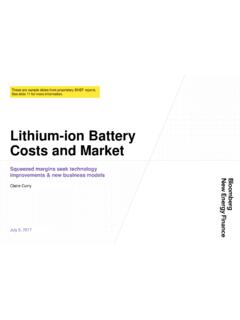Transcription of Hydrogen Economy Outlook - Bloomberg Finance L.P.
1 Hydrogen Economy Outlook Key messages March 30, 2020 Hydrogen Economy Outlook March 30, 2020 Bloomberg Finance No portion of this document may be reproduced, scanned into an electronic system, distributed, publicly displayed or used as the basis of derivative works without the prior written consent of Bloomberg Finance For more information on terms of use, please contact Copyright and Disclaimer notice on page 14 applies throughout. Contents Key messages 1 About us 11 Table of figures Figure 1: Summary of the economics of a Hydrogen Economy .. 1 Figure 2: The many uses of Hydrogen .. 2 Figure 3: Forecast global range of levelized cost of Hydrogen production from large projects .. 3 Figure 4: H2 transport costs based on distance and volume, $/kg, 2019 .. 4 Figure 5: Estimated delivered Hydrogen costs to large-scale industrial users, 2030 .. 5 Figure 6: Estimated delivered Hydrogen costs to large industrial users, 2050.
2 5 Figure 7: Marginal abatement cost curve from using $1/kg Hydrogen for emission reductions, by sector in 2050 .. 6 Figure 8: Levelized cost of steel: Hydrogen versus coal .. 7 Figure 9: Total cost of ownership of SUVs in the , 2030 .. 7 Figure 10: Levelized cost of electricity of Hydrogen -fuelled turbine power plants .. 7 Figure 11: Potential demand for Hydrogen in different scenarios, 2050 .. 8 Figure 12: Indicative estimate of the ability for major countries to generate 50% of electricity and 100% of Hydrogen from wind and PV in a degree scenario .. 9 Table of tables Table 1: Hydrogen storage options .. 3 Table 2: Seven signposts of scale-up toward a Hydrogen Economy .. 10 On April 23, BNEF made two changes to this report. This version corrects a rounding error in the cost range of renewable Hydrogen displayed on page 2 and updates Figure 12 to exclude some countries.
3 Hydrogen Economy Outlook March 30, 2020 Bloomberg Finance No portion of this document may be reproduced, scanned into an electronic system, distributed, publicly displayed or used as the basis of derivative works without the prior written consent of Bloomberg Finance For more information on terms of use, please contact Copyright and Disclaimer notice on page 14 applies throughout. 1 Key messages Hydrogen is a clean-burning molecule that could become a zero-carbon substitute for fossil fuels in hard-to-abate sectors of the Economy . The cost of producing Hydrogen from renewables is primed to fall, but demand needs to be created to drive down costs, and a wide range of delivery infrastructure needs to be built. That won t happen without new government targets and subsidies. These are the key messages of BNEF s Hydrogen Economy Outlook , which provides a global, independent analysis and Outlook for a Hydrogen Economy .
4 A full copy of the Hydrogen Economy Outlook is available for BNEF clients (web | terminal). It draws together analysis and key findings from 12 studies published in 2019 and 2020 from BNEF s Hydrogen Special Project. The full suite of BNEF research on Hydrogen is also available for clients on the Hydrogen theme page (web | terminal). Figure 1: Summary of the economics of a Hydrogen Economy Source: BloombergNEF. Note: Clean Hydrogen refers to both renewable and low-carbon Hydrogen (from fossil-fuels with CCS). Abatement cost with Hydrogen at $1/kg ( ). Currency is US dollars. Hydrogen Economy Outlook March 30, 2020 Bloomberg Finance No portion of this document may be reproduced, scanned into an electronic system, distributed, publicly displayed or used as the basis of derivative works without the prior written consent of Bloomberg Finance For more information on terms of use, please contact Copyright and Disclaimer notice on page 14 applies throughout.
5 2 Meeting climate targets is likely to require a clean molecule Renewable electricity can help reduce emissions in road transport, low-temperature industrial processes and in heating buildings. However, fossil fuels have a significant advantage in applications that require high energy density, industrial processes that rely on carbon as a reactant, or where demand is seasonal. To fully decarbonize the world Economy , it s likely a clean molecule will be needed and Hydrogen is well placed to play this role (Figure 2). It is versatile, reactive, storable, transportable, clean burning, and can be produced with low or zero emissions. Figure 2: The many uses of Hydrogen Source: BloombergNEF Renewable Hydrogen is currently expensive, but costs are coming down In 2018, over 99% of Hydrogen was made using fossil fuels, but Hydrogen can also be produced cleanly using renewable electricity to split water in an electrolyzer.
6 With the cost of wind and solar continuing to fall, the question is whether the cost for electrolyzers and renewable Hydrogen can follow. While they are still expensive in Western markets, there are encouraging signs. The cost of alkaline electrolyzers made in North America and Europe fell 40% between 2014 and 2019, and Chinese made systems are already up to 80% cheaper than those made in the west. If electrolyzer manufacturing can scale up, and costs continue to fall, then our calculations suggest renewable Hydrogen could be produced for $ to $ in most parts of the world before 2050. This is equivalent to gas priced at $6-12/MMBtu, making it competitive with current natural gas prices in Brazil, China, India, Germany and Scandinavia on an energy-equivalent basis, and cheaper than producing Hydrogen from natural gas or coal with carbon capture and storage (Figure 3). Hydrogen Economy Outlook March 30, 2020 Bloomberg Finance No portion of this document may be reproduced, scanned into an electronic system, distributed, publicly displayed or used as the basis of derivative works without the prior written consent of Bloomberg Finance For more information on terms of use, please contact Copyright and Disclaimer notice on page 14 applies throughout.
7 3 Figure 3: Forecast global range of levelized cost of Hydrogen production from large projects Source: BloombergNEF. Note renewable Hydrogen costs based on large projects with optimistic projections for capex. Natural gas prices range from $ , coal from $30-116/t. Transporting and storing Hydrogen needs massive infrastructure investment Hydrogen s low density makes it considerably harder to store than fossil fuels. If Hydrogen were to replace natural gas in the global Economy today, 3-4 times more storage infrastructure would need to be built, at a cost of $637 billion by 2050 to provide the same level of energy security. Storing Hydrogen in large quantities will be one of the most significant challenges for a future Hydrogen Economy . Low cost, large-scale options like salt caverns are geographically limited, and the cost of using alternative liquid storage technologies is often greater than the cost of producing Hydrogen in the first place (Table 1).
8 Table 1: Hydrogen storage options Gaseous state Liquid state Solid state Salt caverns Depleted gas fields Rock caverns Pressurized containers Liquid Hydrogen Ammonia LOHCs Metal hydrides Main usage (volume and cycling) Large volumes, months-weeks Large volumes, seasonal Medium volumes, months-weeks Small volumes, daily Small - medium volumes, days-weeks Large volumes, months-weeks Large volumes, months-weeks Small volumes, days-weeks Benchmark LCOS ($/kg)1 $ $ $ $ $ $ $ Not evaluated Possible future LCOS1 $ $ $ $ $ $ $ Not evaluated Geographical availability Limited Limited Limited Not limited Not limited Not limited Not limited Not limited Source: BloombergNEF. Note: 1 Benchmark levelized cost of storage (LCOS) at the highest reasonable cycling rate (see detailed research for details). LOHC liquid organic Hydrogen carrier. $/MMBtu2019$/kgRenewableH2 Low Carbon H2 (Natural gas with CCS)Low Carbon H2 (Coal with CCS) Hydrogen Economy Outlook March 30, 2020 Bloomberg Finance No portion of this document may be reproduced, scanned into an electronic system, distributed, publicly displayed or used as the basis of derivative works without the prior written consent of Bloomberg Finance For more information on terms of use, please contact Copyright and Disclaimer notice on page 14 applies throughout.
9 4 Low density also makes Hydrogen expensive to transport via road or ship. However, Hydrogen flows nearly three times faster than methane through pipes, making this a cost-effective option for large-scale transport (Figure 4). But for Hydrogen to become as ubiquitous as natural gas, a huge, coordinated program of infrastructure upgrades and construction would be needed, as Hydrogen is often incompatible with existing pipes and systems. Figure 4: H2 transport costs based on distance and volume, $/kg, 2019 Legend: Compressed H2 Liquid H2 Ammonia . Liquid Organic Hydrogen Carriers . Source: BloombergNEF. Note: figures include the cost of movement, compression and associated storage (20% assumed for pipelines in a salt cavern). Ammonia assumed unsuitable at small scale due to its toxicity. While LOHC is cheaper than LH2 for long distance trucking, it is less likely to be used than the more commercially developed LH2.
10 A scaled-up industry could deliver Hydrogen for a benchmark cost of $2/kg in 2030 and $1/kg in 2050 in many parts of the world Hydrogen is likely to be most competitive in large-scale local supply chains. Clusters of industrial customers could be supplied by dedicated pipeline networks containing a portfolio of wind- and solar-powered electrolyzers, and a large-scale geological storage facility to smooth and buffer supply. Our analysis suggests that a delivered cost of green Hydrogen of around $2/kg ($15/MMBtu) in 2030 and $1/kg ($ ) in 2050 in China, India and Western Europe is achievable. Costs could be 20-25% lower in countries with the best renewable and Hydrogen storage resources, such as the , Brazil, Australia, Scandinavia and the Middle east . However, cost would be up to 50-70% higher in places like Japan and Korea that have weaker renewable resources and unfavorable geology for storage (Figure 5 and Figure 6).










